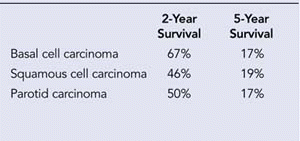“We were able to preserve the inner ear in all patients. We were able to preserve the facial nerve in the majority of patients who did not have facial paralysis at baseline,” he continued.
Dr. Medina stated that the indications for lateral temporal bone resections and subtotal resection are different. The following types of tumors should have lateral temporal bone resection: tumors of the perauricular skin that extend to the auditory canal and the parotid gland immediately adjacent to, adhering to, or superficially invading the temporal bone but not invading the middle ear space or the aerated spaces of the mastoid. Indications for subtotal resection are when the tumor has invaded the middle ear space.
“For example, if a tumor of the pinna or parotid gland is up against the temporal bone or superficially invading the bone, lateral temporal bone resection should be performed. If the tumor invades the middle ear space or aerated spaces of the mastoid and if it does not surround the carotid artery, patients are eligible for subtotal resection,” he stated.
©2007 The Triological Society

Leave a Reply